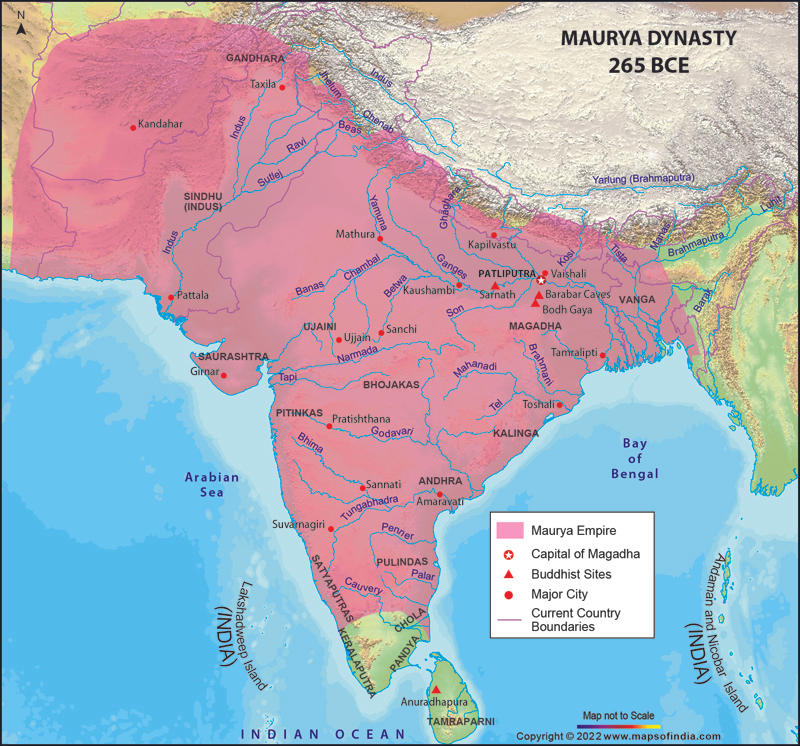The Maurya Empire was an important chapter in Indian history, starting from the Mahajanapada period and ending in an important context in Indian history. Chandragupta Maurya founded it and under his son and leadership, Emperor Ashoka, succeeded in expanding it and making it an influential empire. Due to the contributions of the rulers of the Maurya Empire, their place as an empire is extremely important in Indian history. In this article, we will take an overview of the history, establishment, and significance of the Maurya Empire.
Rise of the Maurya Empire
The Maurya Empire was the first pan-Indian empire. The Maurya Empire was an ancient state in India that was founded by Chandragupta Maurya in 322 BC. The center of this empire was in North India and it extended from Bengal to Hindukush. It covered a large area of present-day Indian territory except Kerala, Tamil Nadu and parts of northeastern India, although it was centered around Magadha. Its range reaches parts of modern Iran. The empire was characterized by a strong central government, an efficient administrative system, and a well-organized army. It also saw the development of a sophisticated legal system, a uniform system of weights and measures, and the spread of Buddhism.
History of Maurya Empire
The Maurya Empire was established by Chandragupta Maurya with the help of Kautilya. The Maurya Empire was established in 321 BC. and continued until 185 BC. The death of Alexander in 323 BC left a large power vacuum, and Chandragupta took advantage, gathered an army and overthrew the Nanda dynasty in Magadha, marking the beginning of the Maurya Empire. After declaring himself king, Chandragupta took additional lands through force and by forming alliances.
Chandragupta's chief minister Kautilya, also known as Chanakya, advised Chandragupta and contributed to the legacy of the empire. Kautilya is also known for writing the Arthashastra, which explains how a state should organize its economy and maintain power. During the reign of Emperor Ashoka, the expansion of the empire was the largest in the Indian subcontinent, covering more than five million square kilometres. It was surrounded on three sides by mountains: the Himalayas, the Ganges River in the north, the Bay of Bengal in the east, the Indus River and the Arabian Sea in the west. Pataliputra, which resembles modern day Patna in Bihar, was the capital of the Maurya Empire.
Sources of the Maurya Empire
Sources for the Maurya Empire include authentic historical evidence, archaeological remains, Buddhist and Jain literature, extant religious and historical texts, and mentions in ancient Indian texts.
- Archaeological Remains: Historians and archaeologists have discovered remains of the Maurya period from various sites. These include the remains of the kingdom's capital Pataliputra (Sampragana), inscriptions from the Ashokan inscriptions, and other excavated remains that reveal the social and cultural life of the Maurya Empire.
- Religious and historical texts: There are many references to the Maurya Empire in Buddhist and Jain religious texts. Information about the Maurya Empire is also found in the Dhamma writings of Ashoka.
- Historical Poetry and Articles: There are also mentions of the Maurya Empire in ancient Indian poetry and writings. Historical information about the Maurya Empire can be found especially in Vishnupuran, Mahabharata, and Jain and Buddhist texts.
Map of Maurya Empire
The territorial expansion of the Maurya Empire can be seen in the given map:
It was spread over more than five million square kilometers. It was surrounded by mountains on three sides: the Himalayas, the Ganges River in the north, the Bay of Bengal in the east, the Indus River and the Arabian Sea in the west as can be seen in the map.

flag of maurya empire
The flag of the Maurya Empire can be seen below:

Ruler of the Maurya Empire
Chandra Gupta Mourya
Chandragupta established the Maurya Empire. He had the support of Chanakya. Chandragupta adopted Jainism towards the end of his life and abdicated the throne in favor of his son Bindusara. According to Jain texts, Chandragupta Maurya adopted Jainism and went to the hills of Shravanabelagola (near Mysore) and died of sallekhana (death by slow starvation).
Bindusara
Bindusara was the second king of the dynasty and was the son of Chandragupta Maurya. He was also called Amitraghat (destroyer of enemies). He apparently ruled the entire Indian land by uniting 16 nations under the Maurya Empire. Bindusara conquered the land between the Arabian Sea and the Bay of Bengal. Under his rule almost the entire subcontinent was under the Maurya Empire. Bindusara maintained friendly diplomatic relations with the Greeks. Deimachus was the ambassador of the Seleucid emperor Antiochus I to the court of Bindusara.
Bindusara had several wives and is believed to have had at least 16 sons, including his most famous son, Ashoka. According to the Buddhist text Ashokavadana, Ashoka was not the eldest son of Bindusara, but he was appointed as the governor of Ujjain during his father's reign. After the death of Bindusara, Ashoka succeeded him as the third Maurya emperor. Although relatively little is known about Bindusara's personal life and achievements, his reign played a significant role in the expansion and consolidation of the Maurya Empire, laying the foundation for the rule of his famous son Ashoka.
Ashoka
Ashoka was the greatest king of the Maurya Empire. As king, he was forceful and ambitious, consolidating the empire's dominance in southern and western India. However, his victory over Kalinga (262–261 BCE) was a defining moment in his life. Seeing the devastation and violence after the Kalinga war, he decided to give up violence and follow the path of non-violence. Ashoka put into practice the principles of non-violence by abolishing sports such as hunting and abolishing forced labor and indentured servitude. The Dhamma Vijaya policy also emphasized nonviolence, which was to be observed by refusing war and conquest, as well as refusing the death of animals.
After Ashoka, there followed a series of less powerful rulers. Ashoka's grandson Dasharatha Maurya succeeded him. His first child Mahinda was intent on popularizing Buddhism everywhere. Due to his eye defect, Kunala Maurya was not good at assuming the throne, and Kaurvaki's descendant Tiwala died even before Ashoka died. Jalouka, another son, has a relatively uneventful background in life. Under Dasharatha, the empire lost huge lands, which Kunala's son Samprati eventually took to regain.
Brihadratha
Brihadratha was the last ruler of the Maurya dynasty, who ruled from approximately 187 BCE to 180 BCE. He was the grandson of Emperor Ashoka and the son of Ashoka's son Kunala. Brihadratha's reign was marked by political instability and internal strife, as many of his ministers and governors sought to increase their power at the expense of the central government. According to tradition, Brihadratha was eventually murdered by his own minister Pushyamitra Shunga, who then founded the Shunga dynasty and became the new rulers of India.
Brihadratha's reign marked the end of the Maurya Empire, once the most powerful empire in India. Despite the decline and eventual fall of the Maurya dynasty, the empire's legacy continued to influence Indian culture and society for centuries to come. The period of Maurya rule was marked by significant advances in art, architecture, literature, science and philosophy, as well as the spread of Buddhism throughout India and beyond.
mauryan economy
- The use of iron tools, diversified agricultural production, huge increase in agricultural land and irrigation facilities contributed to the growth of the Maurya economy.
- The Sohgaura copper plate inscription and the Mahasthan inscription relate to the relief measures adopted during the famine.
- Toll was also imposed on goods brought into the city for sale.
- The general taxation rate was one-sixth of the produce.
- The land given by the state was called “Sita”.
- The Maurya Empire had a strict legal and penal system (civil and criminal); There was a provision for death penalty for tax evaders.
- Punch-marked coins (mostly silver) were used for transactions.
- Money was not only used for trade; The government used to pay its officials in cash.
- The salary ranged from 48,000 panas to 60 panas per year.
- The hired laborers were called 'Karmakar'.
- The state had a monopoly on mining, forests, salt, sale of liquor, manufacture of weapons and metallurgy.
mauryan society
- The society was clearly divided into four varnas, slavery existed in the society.
- The society was divided into several castes and sub-castes which were generally based on some profession or occupation.
- The practice of 'Varna-Shankar marriage' or inter-varna or inter-caste marriage is also found; These were of two types, namely 'Anulom' (groom of higher varna/caste) and 'Pratilom' (bride of higher varna/caste).
- While Kautilya has mentioned 9 categories of slaves, Megasthenes has mentioned its absence. Megasthenes also talks about 7-fold social division.
- The status of women in society seriously deteriorated: widow remarriage stopped, the institution of 'Ganika' (prostitution) expanded.
- Most of the artisans were Shudras, yet, they were paid the lowest wages and subjected to forced labor (Vishti).
Fall of the Maurya Empire
Ashoka's reign ended in 232 BCE, marking the beginning of the decline of the Maurya Empire. Several events were responsible for the fall of the vast empire. They include:
Economic Crisis: The Maurya Empire maintained a very large army, resulting in significant expenditure to pay soldiers and officials, which placed a burden on the Maurya economy. Ashoka opposed the killing of animals and pets. Brahmanical society, which depended on offerings in the name of sacrifices, suffered because of Ashoka's anti-sacrifice attitude. As a result, the Brahmins developed some kind of animosity towards Ashoka.
Diffusion of new knowledge: This material knowledge gained from Magadha served as the foundation for the establishment and expansion of other kingdoms like the Shungas, Kanvas and Chetis.
Overlooking the North-West Frontier: Ashoka was involved in both domestic and international missionary efforts. This left the north-western frontier open to attacks. Also, successive rulers were not capable enough to protect its borders.
Pushyamitra Shunga finally ended the Maurya Empire and established the Shunga dynasty.
Sharing is caring!
